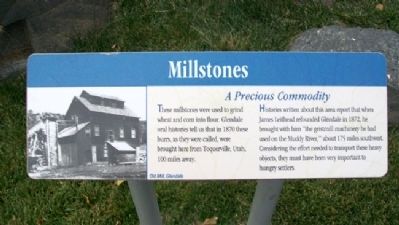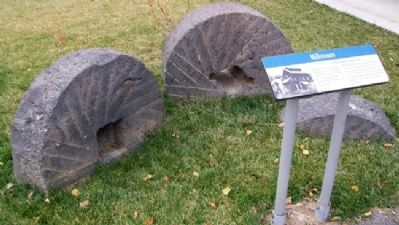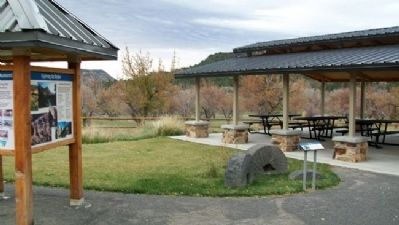Glendale in Kane County, Utah — The American Mountains (Southwest)
Millstones
A Precious Commodity
These millstones were used to grind wheat and corn into flour. Glendale oral histories tell us that in 1870 these burrs, as they were called, were brought here from Toquerville, Utah, 100 miles away.
Histories written about this area report that when James Leithead refounded Glendale in 1872, he brought with him "the gristmill machinery he had used on the Muddy River," about 175 miles southwest. Considering the effort needed to transport these heavy objects, they must have been very important to hungry settlers.
Erected by Bureau of Land Management.
Topics. This historical marker is listed in these topic lists: Agriculture • Industry & Commerce • Man-Made Features • Settlements & Settlers. A significant historical year for this entry is 1870.
Location. 37° 19.22′ N, 112° 35.874′ W. Marker is in Glendale, Utah, in Kane County. Marker is on Main Street, on the left when traveling north. Marker is at the Glendale Orientation Center/Rest Area of the Grand Staircase-Escalante National Monument. Touch for map. Marker is in this post office area: Glendale UT 84729, United States of America. Touch for directions.
Other nearby markers. At least 8 other markers are within 4 miles of this marker, measured as the crow flies. Glendale Orientation Center (here, next to this marker); The Berry Family (about 800 feet away, measured in a direct line); Glendale (approx. 0.3 miles away); United Order Woolen Mill (approx. 1˝ miles away); Orderville Bell (approx. 3.7 miles away); Old Rock Schoolhouse (approx. 3.7 miles away); United Order Industries (approx. 3.8 miles away); Cemetery at Orderville (approx. 4 miles away). Touch for a list and map of all markers in Glendale.
Credits. This page was last revised on September 14, 2020. It was originally submitted on February 23, 2011, by William Fischer, Jr. of Scranton, Pennsylvania. This page has been viewed 615 times since then and 5 times this year. Photos: 1, 2, 3. submitted on February 23, 2011, by William Fischer, Jr. of Scranton, Pennsylvania.


